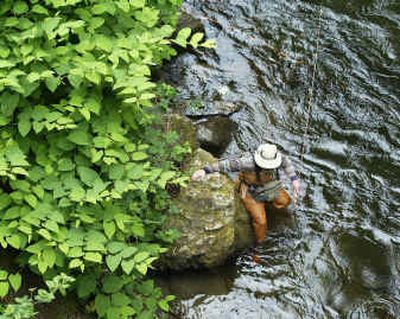Returning to the Cedar

The Cedar was a workingman’s river.
It flowed past cement plants, airplane factories and trailer parks in southeastern King County, feeding Lake Washington, a poor-man’s Puget Sound.
A good share of its water went toward brewing strong, black coffee for Thermoses adorned with the stickers of unions representing aerospace mechanics, longshoremen and carpenters.
Out in the country, we floated the river in inner tubes from Cedar River Auto Parts – “C.R.A.P.,” read the sign. We fished it in summer for hatchery rainbows and the occasional searun cutthroat.
Thirty years ago, we flung bait — typically “periwinkles” plucked from the river bottom and peeled of their rubble shells. We used hand-me-down rods and strung our catch on willow branches. That made us purists, at least as the word was defined by Gene Hill, a favorite outdoor writer of my youth. Hill said a purist was a boy with a can of worms.
The Cedar also had a modest run of winter steelhead, and catching one earned a spot on the bulletin board at Mondale’s Sport Shop, just up the slope from the river in Maple Valley. I wanted to see my own teenaged mug on that board worse than just about anything, and I fished the river hard for three winters, hooking just two steelies and landing neither.
Winter or summer, the fishing was never great. There was never much competition, as anyone with the means to get there went to the Green, the Skykomish or a list of other streams.
All of that is history. Gone like cheap lots on Lake Washington. Like so many of the union jobs. Like Mondale’s Sport Shop. Gone, just as surely as Starbucks lattes have replaced MJB as Seattle’s drink of choice.
Seattle long ago went yuppie; the Cedar followed this month.
Nine years after it was closed to all fishing to protect the steelhead that are also just about gone, the lower 21 miles of the Cedar reopened June 1 under the strictest of regulations.
It’s catch-and-release only. Artificial lures only. Barbless hooks only.
The build-up was phenomenal, with some breathless fly-fishermen predicting that the Cedar would give up wild rainbows as large as 8 pounds. It’s unclear how they arrived at precisely that outlandish measurement.
“It could rival the Yakima or Methow,” a fly-shop owner told the King County Journal, and the opinion spread.
Biologists said most of the trout would be small, but conceded that there were many of them.
It helps that most of the Cedar — everything above the 21-mile point — has been off-limits to loggers, miners, developers, fishermen and just about everyone else for decades.
Seattle’s city watershed protects a de facto wilderness of 90,000 acres — an area more than twice the size of Spokane’s city limits. From it comes drinking water for 1 million souls. Only five other cities in the country have anything like it.
Locals were amazed on opening morning.
Long before daylight, fishermen crowded every turnout along the highway stretch of river, about 10 miles from Maple Valley to Renton. Most waded, but some launched float tubes and pontoon boats. Others stood elbow-to-elbow on Renton’s city bridges.
Reports were mixed. Some anglers caught fish of 20 inches or longer. The Washington Department of Fish and Wildlife reported an average opening-day catch rate of one fish for every angler who put in two hours of casting. But with so many lines flailing the water, a good many fishermen apparently went home disappointed.
“I’m hoping it’ll warm up a bit so a hatch will come off, and then, maybe, we’ll have some fun,” an angler told the Seattle Post-Intelligencer.
My return to the Cedar came nearly two weeks after opening day, after an absence of perhaps 25 years — a period in which I moved to Spokane and learned to cast a fly. I have long since started calling periwinkles what they really are: caddisfly larva.
In other words, I am no longer a purist. None of us are who fish with feathers and $200 rods and return most of our catch to the water. Catch-and-release is to fishing what treadmills are to running.
It was pouring rain when I drove to Landsburg, which is not a town or even a junction, but a spot in the woods where a paved road crosses the river. The bridge at Landsburg has always marked the upstream limit of legal fishing on the Cedar.
Just 100 feet above the bridge is the watershed boundary. People come here in late summer to watch as sockeye salmon try futilely to leap a low-head dam.
I walked downstream, out of earshot of the traffic, on a trail where there used to be railroad tracks. We hunted here sometimes, my dog Scout and I. The trail still draws people and their dogs, though hunting is forbidden here, as it is at all my old grouse haunts.
The storm meant I had the river mostly to myself, although 13 days into the season fishermen had already worn paths from the old rail bed to the water. I stood in strong current up to my thighs, looking up at the rain and the maples whose crowns nearly meet at midstream. The Cedar was prettier than I remembered; smaller, too, even swollen with rain.
In 90 minutes I made maybe 100 casts, drawing two strikes. That says more about me than the river; I’ve had similar poor results on the Yakima, despite its reputation, and have learned to find enjoyment just the same.
Back at the truck, stripping out of waders, I noticed a snelled bait hook in the gravel. I should have frowned, the way I do when I see such evidence of violations on the Spokane or the St. Joe. Northwest trout streams are too crowded for purists.
I couldn’t help smiling.